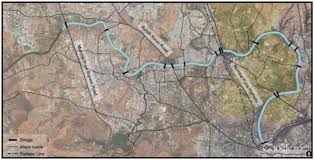The Mula-Mutha River has long been a lifeline for Pune, shaping the city’s geography, history, and culture. Once a clean and vibrant waterbody that supported communities and biodiversity, it now struggles with severe pollution and ecological degradation. As Pune continues to grow, so does the urgency to restore this vital river to its former glory.
Geographical Overview
Mapping the Mula-Mutha River
The Mula-Mutha River is formed by the confluence of two rivers:
- Mula River: Originates from the Mulshi Dam in the Sahyadri Hills.
- Mutha River: Emerges from the Khadakwasla Dam, fed by the Ambi and Mose rivers.
The rivers meet near Sangam Bridge, a significant landmark in Pune. From there, the Mula-Mutha River flows eastward through key areas like Bund Garden, Koregaon Park, Yerwada, and Kharadi, eventually joining the Bhima River near Daund, which is a tributary of the Krishna River.
Key Infrastructure
- Dams: Mulshi Dam (Mula) and Khadakwasla Dam (Mutha) regulate the flow.
- Bridges & Neighborhoods: Sangam Bridge, Bund Garden Bridge, Mundhwa, and Kharadi are some of the river’s urban landmarks.
Visual Element : Mula-Mutha River Map

Historical Significance
Maratha Empire
The river system was crucial for defense and transport during the Maratha era. Shaniwar Wada, the seat of the Peshwas, and Sinhagad Fort strategically overlooked these waters.
British Colonial Era
The British introduced canal systems for irrigation and created green spaces like Bund Garden, reflecting the river’s utility and charm.
Independence Movement
During India’s freedom struggle, the riverbanks became symbolic spaces for gatherings, speeches, and planning sessions by local leaders.
Cultural and Social Importance
Religious Practices
The Mula-Mutha is a central location for Ganesh Chaturthi idol immersion, a practice that, while culturally significant, has contributed to the river’s pollution.
Artistic Legacy
Poets like Sant Tukaram and artists have drawn inspiration from the river’s tranquil past. Even today, it features in art, literature, and photography.
Community Spaces
Parks like Saras Baug and riverside temples have historically served as social and recreational venues, fostering a deep connection between residents and the river.
Environmental Challenges
Pollution Hotspots
- Sewage: Numerous nullahs, especially around Shivajinagar and Yerwada, dump untreated sewage into the river.
- Industrial Waste: Effluents from nearby Kharadi IT parks and small manufacturing units worsen contamination.
- Festival Waste: Post-Ganesh Chaturthi, idol materials and plastic waste choke the river.
Health & Ecological Impact
- High BOD (Biochemical Oxygen Demand): Indicates low oxygen availability, making it uninhabitable for most aquatic life.
- Loss of Biodiversity: Native fish and bird species have declined sharply.
- Public Health: Increased incidence of waterborne diseases in nearby slum areas.
Statistical Evidence
A 2015 CPCB report listed the Mula-Mutha among India’s most polluted rivers. Despite being a vital urban waterbody, it ranks poorly in water quality indices.
Conservation Efforts
Government Initiatives
- Mula-Mutha Riverfront Development Project: Backed by JICA (Japan International Cooperation Agency), this Rs 4,727-crore initiative includes STPs, interceptors, beautification, and flood control mechanisms.
- STPs (Sewage Treatment Plants): 11 new STPs are under construction to treat and reuse wastewater.
- Legal Mandates: The National Green Tribunal (NGT) has ordered strict pollution control and monitoring mechanisms.
Community Action
- NGOs: Organizations like Jeevit Nadi conduct clean-up drives, awareness campaigns, and ecological surveys.
- Eco-Friendly Initiatives: Campaigns promoting clay idols and designated immersion tanks aim to reduce festive pollution.
Challenges and Controversies
Urbanization Pressures
Pune’s rapidly growing population and urban sprawl have strained existing infrastructure, leading to rampant sewage discharge and informal settlements along riverbanks.
Criticism of Riverfront Project
While the development promises aesthetic transformation, critics argue it prioritizes beautification over ecological restoration. Concerns include:
- Displacement of slum communities.
- Reduction of natural wetlands.
- Inadequate focus on water quality improvement.
Implementation Delays
Multiple hurdles, including bureaucratic red tape, inter-departmental coordination issues, and funding gaps, have delayed progress.
Future Prospects
Integrated Solutions
- Hybrid Infrastructure: Combining STPs with natural wetlands to filter runoff.
- Rainwater Harvesting: Encouraged in urban planning to reduce runoff.
Technological Innovations
- AI-Based Monitoring: Real-time sensors and data analytics to track pollution levels and predict environmental risks.
Public Engagement
- Education Programs: Workshops, school curriculum integration, and local campaigns to promote waste segregation and sustainable lifestyle choices.
- Citizen Science: Community participation in water quality testing and policy feedback.
Conclusion
The Mula-Mutha River, once a cradle of civilization and culture in Pune, is now in urgent need of rejuvenation. Through a blend of community engagement, technological innovation, and sustainable infrastructure, Pune has a chance to restore the river—not just as a water source, but as a symbol of environmental responsibility. As citizens, staying informed and involved is the first step in this vital journey to Save Mula-Mutha River.